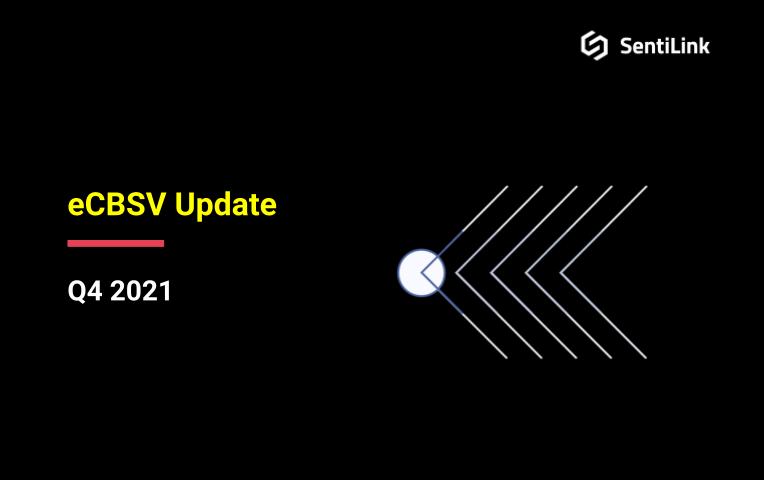Blog post
30 million and counting: How It started/how it's going with eCBSV
Jason Kratovil
Published
December 15, 2021

When SentiLink started down the road with SSA back in 2019, the vision for the real-time SSN verification service was mired in struggles over privacy, cybersecurity and finding a workable technical solution that threaded the needle between the needs of a diverse financial industry and a sprawling federal agency's antiquated technology stack.
Today those issues have been largely resolved, the system has processed over 30 million verification requests, and SSA is rapidly moving toward open enrollment for the whole of industry.
So how are things going?
In short: It's working about as well as we hoped it would. To date, the system has processed about 30 million verification requests -- a small fraction of the estimated 300 million annual verifications expected once fully up and running, but significantly more than the 5 million back in March 2021. As the first eCBSV provider, we've had a lot of time to see its impact on the industry and consumers. Some recent analysis:
Match rates down as strategies change
Earlier this year, we published a progress report in which we noted the match rate - - i.e., when eCBSV says "Yes, the name, DOB and SSN you provided match with a living person" - - was about 95%. In the most recent quarter, we observed a match rate of 93.3% across all our partners using SentiLink for eCBSV. As our partners' experience with the system has matured, so has their utilization strategies. Some continue to send most, if not all, applicants through eCBSV at the top of the application funnel. Realistically, these partners are likely experiencing similar trends as we reported in Q1, i.e. 5% mismatches. Where a partner has moved eCBSV lower in the application funnel, or in cases where eCBSV is only being used when fraud flags are already being triggered, mismatch rates will be higher, i.e. as we observed in Q3.
69% of mismatches are not fraud
Of the 6.7% that were returned as a "No" match/mismatch, we identified 31% as malicious fraud attempts (compared to 25% in Q1). That means 69% of mismatches aren't fraud due to things like "fat-finger" typos. This nuance is important to keep in mind for financial institutions looking to approve more applicants.
Response times improving even as volume increases
In the most recent quarter, eCBSV was averaging a response time of 280ms (compared to 345ms in Q1).
System uptime and availability improving
In Q1, eCBSV had three major unplanned outages resulting in more than an hour of downtime with each incident. In the most recent quarter, the system experienced only one minor outage of approximately 15 minutes and which did not result in any transactions failing.
Proving its value to individual consumers
Just as important as the macro impact, eCBSV has been able to help individual consumers get access to financial services, including immigrants and those with no or thin-file credit histories. Consider these examples where SentiLink's team of risk analysts worked directly with our partners on cases where eCBSV made all the difference:
- A partner financial institution was presented with an identity on an application that appeared extremely new. On closer inspection, the individual was shown to have a lengthy history with an ITIN, but it was theorized may have been applying with a newly issued random SSN, which could not be verified by traditional means. Here, a bottom-of-funnel request to eCBSV provided the conclusive evidence that this was a legitimate applicant and the partner was able to establish an account with the consumer.
- A partner escalated a case to our risk operations team involving a thin-file applicant with a randomly issued SSN. However, with only scant "signs of life" found online indicating the applicant might be an international student, it was not possible to make a determination if the SSN was legit, stolen, or completely fabricated. Again, eCBSV provided a "Yes" match, resulting in a lower friction onboarding process for the applicant and peace of mind for the partner.
While it's too soon to quantify how eCBSV is benefitting the underserved/unbanked, it's clearly having an impact by helping financial institutions reach more eligible borrowers.
eCBSV is a game changer for banks and lenders working to prevent synthetic identities. Not only can eCBSV help to detect fake identities, but it can increase approval rates for thin files. Overall, eCBSV is a major leap forward in resolving questions of identity as part of the digital account opening process.
________________________________________

Jason Kratovil is the Head of Public Policy for SentiLink. From 2016 - 2018, he led the effort to create and enact the legislation that became the eCBSV.
Related Content

Blog article
December 2, 2025
The Identity-Theft Risk Profile of NBA and NFL Draft Prospects
Read article
Blog article
November 21, 2025
CIP Requirements: What Financial Institutions Need to Know
Read article
Blog article
November 7, 2025